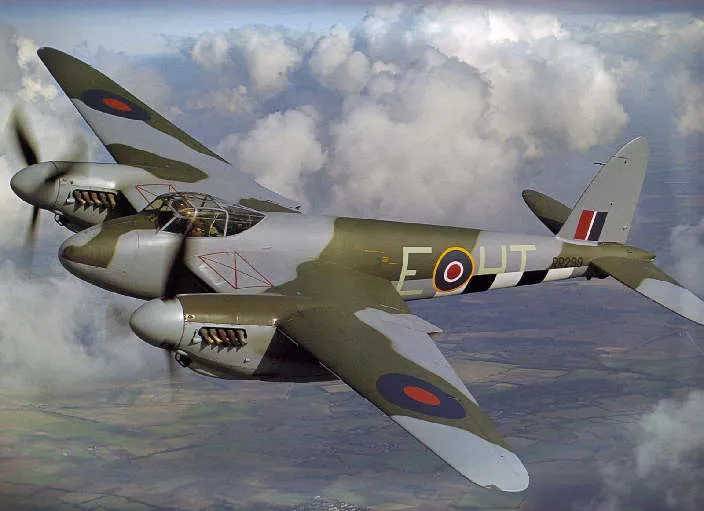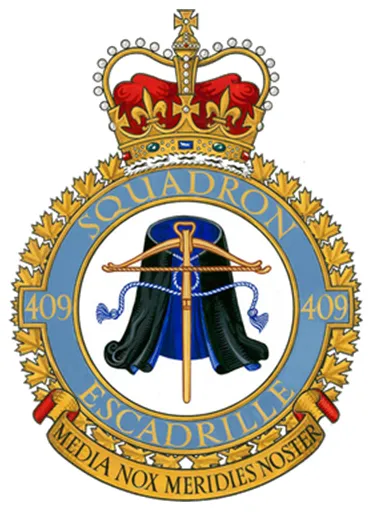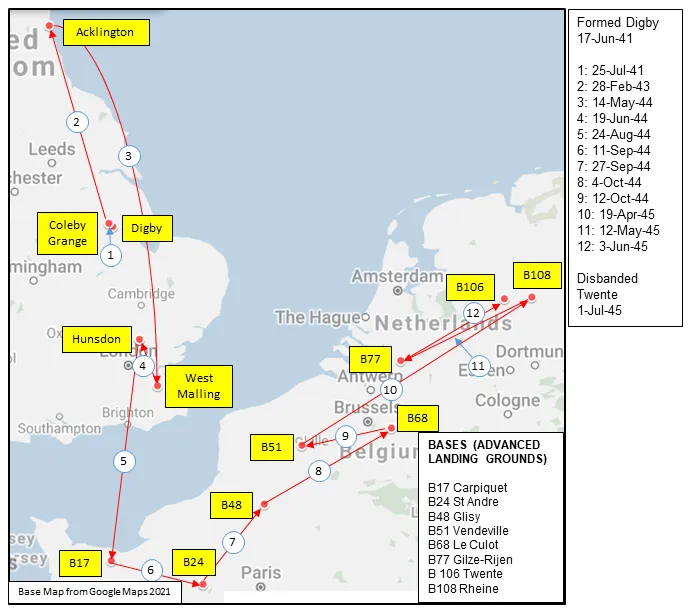Sisson, Arnold Bruce (Flight Lieutenant)
Prisoner of War 1944-June-16


Birth Date: unkown date
Born:
Parents:
Spouse:
Home: Elm Creek, Manitoba
Enlistment:
Enlistment Date: unkown date
Service
RCAF
Unit
409 Sqn- Squadron
Media Nox Meridies Noster Midnight is Our Noon
Base
Rank
Flight Lieutenant
Position
Service Numbers
J/21421
PoW: 7491
Mosquito serial: MM576

The de Havilland DH.98 Mosquito was a British twin-engine shoulder-winged multi-role combat aircraft, introduced during the Second World War. It was one of few operational front-line aircraft of the era whose frame was constructed almost entirely of wood. Nicknamed The Wooden Wonder, it was affectionately as the "Mossie" to its crews. The total number of DH98 Mosquito aircraft built was 7,781, the type serving with the main Allied air forces, including both the United States and Russia.
When Mosquito production began in 1941 it was the fastest propeller driven operational aircraft in the world. The first variant was an unarmed, high-speed, high-altitude photo-reconnaissance aircraft. Originally conceived as an unarmed fast bomber, the Mosquito's use evolved during the war into many roles including low to medium-altitude daytime tactical bomber, high-altitude night bomber, pathfinder, day or night fighter, fighter-bomber, intruder, and maritime strike aircraft. It was also used by the British Overseas Airways Corporation (BOAC) as a fast transport to carry small high-value cargoes to, and from, neutral countries, through enemy-controlled airspace. The crew of two, pilot and navigator, sat side by side, but a single passenger could ride in the aircraft's bomb bay when necessary.
The Mosquito FB Mk. VI was often flown in special raids, such as Operation Jericho, an attack on Amiens Prison in early 1944, and precision attacks against military intelligence, security and police facilities (such as Gestapo headquarters). On the 10th anniversary of the Nazi' seizure of power in 1943, a morning Mosquito attack knocked out the main Berlin broadcasting station while Hermann Goering was speaking, putting his speech off the air. Goering later said: "It makes me furious when I see the Mosquito. I turn green and yellow with envy. There is nothing the British do not have. They have the geniuses and we have the nincompoops."
The Mosquito flew with the RCAF and other air forces in the European, Mediterranean and Italian theatres. After the end of the Second World War Spartan Air Services flew 10 ex-RAF Mosquitoes, mostly B.35's plus one of only six PR.35's built, for high-altitude photographic survey work in Canada. There are approximately 30 non-flying Mosquitos around the world with five airworthy examples, four in the United States, and one in Canada. Harold Skaarup web page and Wikipedia
![]() BAE Systems (formerly De Havilland)
BAE Systems (formerly De Havilland)
Unit Desciption
409 Sqn Media Nox Meridies Noster ("Nighthawk" )
History of the Squadron during World War II (Aircraft: Defiant I, Beaufighter IIF, VIF, Mosquito NF XIII)

The squadron was formed at Digby, Licolnshire UK  on June 17, 1941 as the RCAF’s 7th squadron formed overseas during WWII. It was designated as a night fighter unit and was originally equipped with Boulton Paul Defiant Mk. 1 aircraft. These were rapidly superseded in September 1941 by Bristol Beaufighter Mk. IIF night fighter aircraft. The squadron participated in the night air defence of Great Britain and its first victory was registered in November 1941 by the CO, Wing Commander Paul Davoud. From July 1941 to February 1943 the squadron was based at Coleby Grange, Lincolnshire. In June 1942 the squadron re-equipped with the Beaufighter VIF. In February 1943 t6he squadron moved to Acklington, Northumberland where it remained until February 1944. At that time, while remaining at Acklington, the squadron became part of No 147 (RAF) Wing of the Second Tactical Air Force. It re-equipped with de Havilland Mosquito NF Mk XIII aircraft and after short stays at West Malling, Kent and Hunsdon, Hertfordshire, during which it covered the D-Day landings, it was the first night fighter squadron to cross to Normandy and operate from the Continent. Thereafter it followed the invading troops through France, Belgium, the Netherlands and finally Germany. From the period June 1944 to May 1945 it was the top-scoring RAF/RCAF night fighter unit. Its tally was 58½ aircraft and12 V-1 flying bombs. The squadron was disbanded at Twente, the Netherlands
on June 17, 1941 as the RCAF’s 7th squadron formed overseas during WWII. It was designated as a night fighter unit and was originally equipped with Boulton Paul Defiant Mk. 1 aircraft. These were rapidly superseded in September 1941 by Bristol Beaufighter Mk. IIF night fighter aircraft. The squadron participated in the night air defence of Great Britain and its first victory was registered in November 1941 by the CO, Wing Commander Paul Davoud. From July 1941 to February 1943 the squadron was based at Coleby Grange, Lincolnshire. In June 1942 the squadron re-equipped with the Beaufighter VIF. In February 1943 t6he squadron moved to Acklington, Northumberland where it remained until February 1944. At that time, while remaining at Acklington, the squadron became part of No 147 (RAF) Wing of the Second Tactical Air Force. It re-equipped with de Havilland Mosquito NF Mk XIII aircraft and after short stays at West Malling, Kent and Hunsdon, Hertfordshire, during which it covered the D-Day landings, it was the first night fighter squadron to cross to Normandy and operate from the Continent. Thereafter it followed the invading troops through France, Belgium, the Netherlands and finally Germany. From the period June 1944 to May 1945 it was the top-scoring RAF/RCAF night fighter unit. Its tally was 58½ aircraft and12 V-1 flying bombs. The squadron was disbanded at Twente, the Netherlands  on July 1, 1945. The squadron had one ace, Flight Lieutenant R.I.E. Britten. Awards included 2 MBE, 1 DSO, 1 Bar to DFC, 13 DFCs, 2 AFCs, 2 BEMs, 7 MiD and 1 DFC (USA). Battle Honours are: Defence of Britain 1941-44, Fortress Europe 1942-44, France and Germany 1941-45, Normandy 1944, Rhine.Wikipedia, Kostenuk and Griffin
on July 1, 1945. The squadron had one ace, Flight Lieutenant R.I.E. Britten. Awards included 2 MBE, 1 DSO, 1 Bar to DFC, 13 DFCs, 2 AFCs, 2 BEMs, 7 MiD and 1 DFC (USA). Battle Honours are: Defence of Britain 1941-44, Fortress Europe 1942-44, France and Germany 1941-45, Normandy 1944, Rhine.Wikipedia, Kostenuk and Griffin
Maps for Movements of 409 Squadron 1941-45

409 Squadron History Summary 1941-45

408 Squadron History Summary 1941-45 Page 2

History of the Squadron Post-WWII (Aircraft: CF-100, Voodoo, CF-18 Hornet)
The squadron was re-established at RCAF Station Comox, British Columbia  on 1 November 1954 to provide air defence for Canada's west coast as part of NORAD. Initially equipped with the Canadian designed Avro CF-100 they converted to the CF-101 Voodoo in 1962. The squadron transferred to CFB Cold Lake in 1984 to convert to the CF-18 and then deployed to CFB Baden-Soellingen, Germany
on 1 November 1954 to provide air defence for Canada's west coast as part of NORAD. Initially equipped with the Canadian designed Avro CF-100 they converted to the CF-101 Voodoo in 1962. The squadron transferred to CFB Cold Lake in 1984 to convert to the CF-18 and then deployed to CFB Baden-Soellingen, Germany  as part of Canada's NATO commitment. In October 1990, the squadron was deployed to the Persian Gulf, becoming the first Canadian squadron to see active service since WWII. Tasked with air defence of the allied fleet in the Persian Gulf, the squadron flew operational sorties immediately on arrival at Desert Home (Canada Dry 1 and 2) in Doha, Qatar. While on active duty, the squadron flew over 100 hours in the Middle East without any flight safety incidents. The squadron was then disbanded in 1991 with the withdrawal of Canadian Forces from Europe.
as part of Canada's NATO commitment. In October 1990, the squadron was deployed to the Persian Gulf, becoming the first Canadian squadron to see active service since WWII. Tasked with air defence of the allied fleet in the Persian Gulf, the squadron flew operational sorties immediately on arrival at Desert Home (Canada Dry 1 and 2) in Doha, Qatar. While on active duty, the squadron flew over 100 hours in the Middle East without any flight safety incidents. The squadron was then disbanded in 1991 with the withdrawal of Canadian Forces from Europe.
The squadron was briefly reformed back at Comox as a Combat Support Squadron (without aircraft) but was disbanded again.
409 Tactical Fighter Squadron was re-formed by the consolidation of 416 and 441 Tactical Fighter Squadrons on 6 July 2006 at CFB Cold Lake, Alberta  . On 30 June 2015, personnel and equipment from 409 Tac F Sqn were reassigned to 401 Tac F Sqn, one of two Tac F Sqns within the Royal Canadian Air Force which were stood back up. The squadron complements the duties of 401 Tac F Sqn and, assisted by 410 Tactical Fighter (Operational Training) Squadron, deploys tactical fighter forces to meet Canadian and allied defence needs. Under the umbrella of the NORAD mission, fighter crews are on stand-by 24/7, ready to respond to any aerospace threat. The squadron is now one of two operational CF-18 Squadrons at 4 Wing Cold Lake.
. On 30 June 2015, personnel and equipment from 409 Tac F Sqn were reassigned to 401 Tac F Sqn, one of two Tac F Sqns within the Royal Canadian Air Force which were stood back up. The squadron complements the duties of 401 Tac F Sqn and, assisted by 410 Tactical Fighter (Operational Training) Squadron, deploys tactical fighter forces to meet Canadian and allied defence needs. Under the umbrella of the NORAD mission, fighter crews are on stand-by 24/7, ready to respond to any aerospace threat. The squadron is now one of two operational CF-18 Squadrons at 4 Wing Cold Lake.